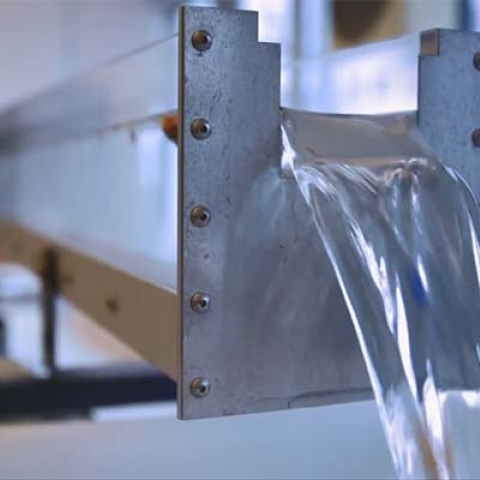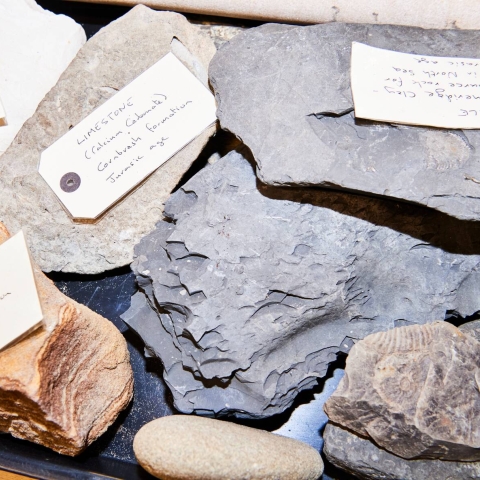
Climate change, environmental pollution and contamination, and the increasing scarcity of our planet’s natural resources are some of the biggest threats to humanity.
Our Environmental Processes and Change research looks at the Earth's changing environment and the influence of human activity on climate and ecosystems. We aim to understand natural climate variations and their interaction with human activities, considering the impact of population growth on the Earth's environment. Our research also provides innovative solutions to environmental crises and aims to mitigate the risks of climate change.
To mitigate the future risk from climate change, we're making local assessments in diverse ecosystems and hydrosystems worldwide, addressing issues such as melting glaciers, floods, heat waves, forest fires, and natural disasters. We also contribute to the design of sustainable urban environments for both humans and biodiversity while exploring the science of decay and its economic, political, and cultural contexts.
Through our Environmental Processes and Impacts research, we also study the movement and effects of contaminants and pollutants in the environment – collaborating with industry partners, including water companies, environmental consultants, and nuclear regulators, to identify challenges and develop solutions.
We also work with organisations and regulators worldwide in sustainable resource management to meet the growing demands for food and energy, and enhance monitoring techniques for hazardous environmental pollutants.
Our work explores the following topics
- Environmental science and impacts
- Hydrogeology, water quality and fluvial geomorphology
- Marine biogeochemistry
- Marine environmental science and coastal processes
- Radioactivity and radiation
- Ecotoxicology and ecology
- Environmental modelling and climate science
- Water, air and soil pollution
- Palaeoclimate and Environmental Reconstruction
- Passive sampling
- Environmental monitoring and assessment
- Emerging contaminants and microplastics
- Antimicrobial resistance
- Environmental chemistry, weathering and mineralogy
- Quaternary Science and glaciology
- Natural Hazards and wildfires
- Volcanology/Tephrochronology
Our research boasts exceptional laboratories and facilities – including Chemcatcher®, a cost-effective passive sampling device developed by our researchers and colleagues at Chalmers University of Technology, Sweden, which can replace established water monitoring approaches that rely on infrequent spot or bottle sampling.
We partner and collaborate with many private companies, universities, regulatory bodies and environmental consultancies, including:
- Fukushima University, Japan
- The State Agency for Exclusion Zone Management, Ukraine
- The Society of Environmental Toxicology and Chemistry (SETAC)
- The International Network for Environmental Forensics (INEF)
- DustScanAQ: Dust Monitoring & Air Quality Consultants
Our work has been featured in many publications, including Environmental Science and Technology, Science of the Total Environment, Environmental Science: Processes and Impacts, and Climatic Change. We have received significant project funding from major organisations, such as the Natural Environment Research Council (NERC) and the Department of Trade and Industry (DTI).
Our work has been covered widely by mainstream media – with our recent work on abundant wildlife populations at Chernobyl being covered around the world by the likes of Reuters, BBC, The Guardian, CNN, New Scientist, The Washington Post, El Pais and Le Figaro.
Methods and facilities
The University of Portsmouth is home to exceptional facilities that shape the work we do – including our earth surface materials laboratory, sediment and tephra laboratory, infrared Fourier transform spectrometer, laser granulometer, and ground penetrating radar.
We use laboratory and field-based methods in our research, including quantitative observations, satellite data, remote sensing, modelling, experimental analysis in the laboratory and field, and simulation of complex environmental conditions.
We regularly collaborate with major industry and academic partners on our research, including the National Trust, Forest Research and Historic England.
Environmental Chemistry Analysis Laboratory
Use the equipment in this lab to identify and analyse chemicals and biochemicals in surface water, groundwater and soil, so you can develop strategies to minimise and remove their harmful environmental effects.

GIS and Remote Sensing Facilities
Discover more about the planet's physical structures and scientific processes, such as glaciers and coastal flooding, using drone data, aerial and satellite remote sensing and geographic information systems.

Physical Geography and Meteorology Laboratories
Use the latest physical and meteorological equipment in our labs, including a rainfall simulator and automatic weather stations.

Publication highlights
-
Mass loss of glaciers and ice caps across Greenland since the Little Ice Age
Carrivick, J. L., Boston, C., Sutherland, J., Pearce, D., Armstrong, H., Bjørk, A., Kjeldsen, K., Abermann, J., Oien, R., Grimes, M., James, W. H. M., and Smith, M. W. (2023) "Mass loss of glaciers and ice caps across Greenland since the Little Ice Age", Geophysical Research Letters
-
Beyond stationarity: influence of flow history and sediment supply on coarse bedload transport
Downs, P. W., and Soar, P. J. (2021) "Beyond stationarity: influence of flow history and sediment supply on coarse bedload transport", Water Resources Research
-
A miniaturized passive sampling-based workflow for monitoring chemicals of emerging concern in water
Richardson, A. K., Irlam, R. C., Wright, H. R., Mills, G. A., Fones, G. R., Stürzenbaum, S. R., Cowan, D. A., Neep, D. J., and Barron, L. P. (2022) "A miniaturized passive sampling-based workflow for monitoring chemicals of emerging concern in water", Science of the Total Environment
-
Natural attenuation processes control groundwater contamination in the Chernobyl exclusion zone: evidence from 35 years of radiological monitoring
Bugai, D., Kireev, S., Hoque, M., Kubko, Y., and Smith, J. (2022) "Natural attenuation processes control groundwater contamination in the Chernobyl exclusion zone: evidence from 35 years of radiological monitoring", Scientific Reports
-
Climate changes and their elevational patterns in the mountains of the world
Pepin, N. C., Arnone, E., Gobiet, A., Haslinger, K., Kotlarski, S., Notarnicola, C., Palazzi, E., Seibert, P., Serafin, S., Schöner, W., Terzago, S., Thornton, J. M., Vuille, M., and Adler, C. (2022) "Climate changes and their elevational patterns in the mountains of the world", Reviews of Geophysics
-
Microbial ecosystem responses to alkalinity enhancement in the North Atlantic Subtropical Gyre
Subhas, A., Marx, L., Reynolds, S., Flohr, A., Mawji, E., Brown, P., and Cael, B. B. (2022) "Microbial ecosystem responses to alkalinity enhancement in the North Atlantic Subtropical Gyre", Frontiers in Climate
-
Prospects of emerging PAH sources and remediation technologies: insights from Africa
Sam, K. S., Onyena, A. P., Zabbey, N., Odoh, C. K., Nwipie, G. N., Nkeeh, D. K., Osuji, L. C., and Little, D. I. (2023) "Prospects of emerging PAH sources and remediation technologies: insights from Africa" Environmental Science and Pollution Research
-
Crowd-sourcing observations of volcanic eruptions during the 2021 Fagradalsfjall and Cumbre Vieja events
Wadsworth, F. B., Llewellin, E. W., Farquharson, J. I., Gillies, J. K., Loisel, A., Frey, L., Ilyinskaya, E., Thordarson, T., Tramontano, S., Lev, E., Pankhurst, M. J., Rull, A. G., Asensio-ramos, M., Pérez, N. M., Hernández, P. A., Calvo, D., Solana, C., Kueppers, U., and Santabárbara, A. P. (2022) "Crowd-sourcing observations of volcanic eruptions during the 2021 Fagradalsfjall and Cumbre Vieja events", Nature Communications
-
A review of the current status of flood modelling for urban flood risk management in the developing countries
Nkwunonwo, U. C., Whitworth, M., and Baily, B. (2020), "A review of the current status of flood modelling for urban flood risk management in the developing countries", Scientific African
-
Eruptive activity of the Santorini Volcano controlled by sea level rise and fall
Satow, C., Gudmundsson, A., Gertisser, R., Bronk Ramsey, C., Bazargan, M., Pyle, D., Wulf, S., Miles, A., and Hardiman, M. (2021) "Eruptive activity of the Santorini Volcano controlled by sea level rise and fall", Nature Geoscience
Project highlights
-
Understanding the impacts of climate change on Kilimanjaro, Tanzania
Monitoring long term changes in climate along the elevational gradient in Kilimanjaro.
-
Cold Air Pooling and Changing Microclimate in Arctic Lapland: Downscaling the Impacts of Climate Change
Measuring air temperature and relative humidity in the Kevo Sub Arctic Research Station in northern Finland.
-
Community knowledge and the hidden history of Greenland’s fires
Understanding the history of wildfires in western Greenland and their impact on communities.
-
Water quality monitoring in the Kishon River catchment using Chemcatcher passive sampler
Screening and quantification for pesticides and pharmaceuticals in the Kishon river catchment.
Explore more of our research
Crustal Evolution and Tectonics Research Group
We're addressing fundamental questions about the Earth's systems, such as when plate tectonics began operating and how changes in the style and rate of plate movement can be documented through time.

Palaeontology and Environmental Change Research Group
We're exploring how fossil records can help us understand past climates and environments, and effectively predict and model climate change and its impact on the Earth’s ecosystems.

